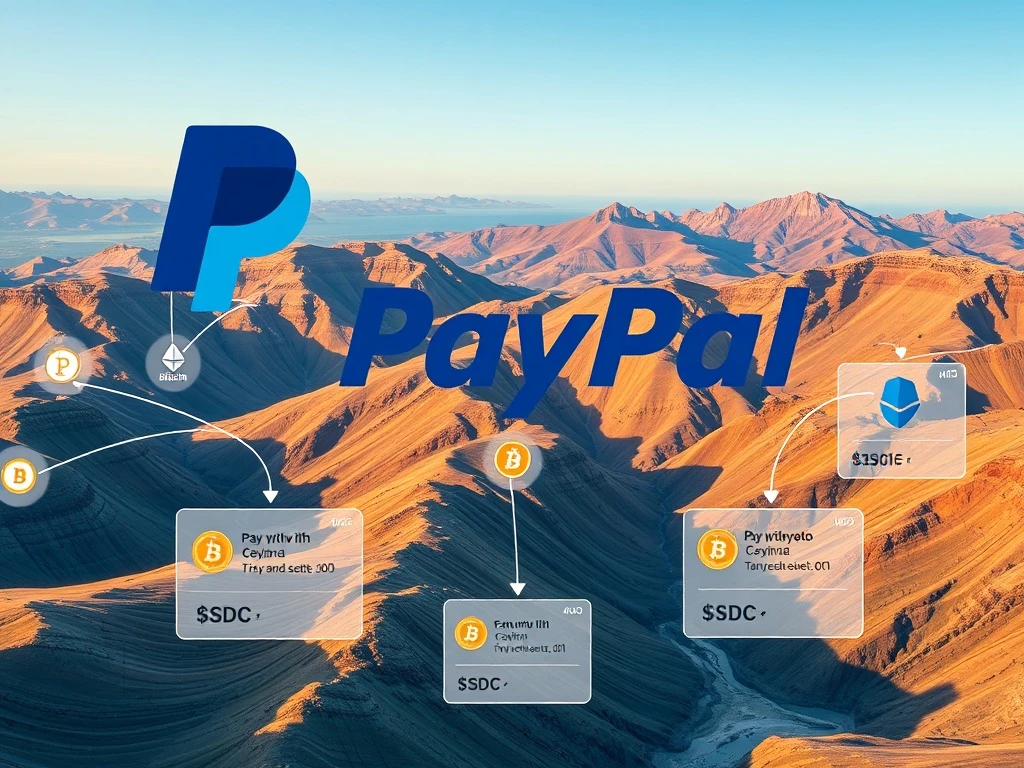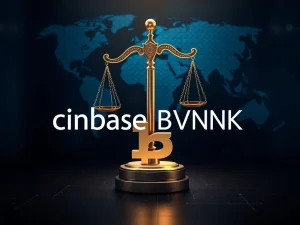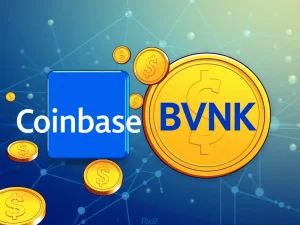Revolutionary PayPal Crypto Payments: Unlocking Global Commerce for Millions

The financial world is witnessing a significant shift. PayPal, a global payment giant, has launched a groundbreaking feature. This new service promises to transform how we view digital currencies. Indeed, PayPal crypto payments are now accessible to US merchants. This move unlocks the potential of cryptocurrency for an enormous user base. It truly signals a new era for mainstream crypto adoption.
Understanding ‘Pay with Crypto’ by PayPal
PayPal’s innovative ‘Pay with Crypto’ feature is a blockchain-based settlement tool. It specifically targets US merchants. This system facilitates payments using over 100 cryptocurrencies. These include major assets like Bitcoin (BTC), Ether (ETH), and Solana (SOL). Popular stablecoins such as USDC (USDC) and Tether’s USDt (USDT) are also supported. XRP (XRP) and BNB (BNB) further expand the available options. Essentially, consumers can pay with their chosen digital asset. However, merchants receive their payouts in either US dollars or PayPal USD (PYUSD). PYUSD is PayPal’s own dollar-pegged stablecoin.
This automatic crypto-to-fiat conversion is crucial. It ensures merchants have no exposure to price volatility. Consequently, it offers a familiar settlement process. This process mirrors traditional payouts, providing stability. Furthermore, this Pay with Crypto tool is designed for broad compatibility. Shoppers can use various external wallets. These include Coinbase Wallet, MetaMask, Binance, Kraken, Phantom, and Exodus. There is no requirement to pre-transfer funds into PayPal. The entire process is remarkably streamlined. Users simply connect an external wallet at checkout. They then pay directly from that wallet. PayPal has effectively removed legacy barriers. It has embedded crypto payments directly into its robust wallet infrastructure. US merchants can now accept cross-border payments effortlessly. They benefit from instant settlement and stable-value payouts. This approach significantly expands PayPal’s global reach. Overall, it marks a major step in PayPal enabling crypto for merchants at scale. Notably, PayPal’s inaugural corporate payment using PYUSD occurred on September 23, 2024. This transaction went to Ernst & Young via SAP’s digital platform.
PayPal Crypto Payments: A Gateway to Mainstream Adoption
The year 2025 is shaping up to be pivotal for cryptocurrency. PayPal crypto payments are becoming a powerful driver for mainstream adoption. With ‘Pay with Crypto,’ PayPal is unlocking access to a vast digital economy. This economy is estimated at $3 trillion. It also targets a potential audience of 650 million crypto users. This represents a massive leap from PayPal’s existing 426 million account holders. PayPal is therefore expanding its footprint significantly. It moves from fiat-native users to crypto-native spenders. This expansion occurs by overlaying stablecoin-enabled transactions onto its existing infrastructure.
This strategy includes seamless support for PayPal stablecoin integration. It also involves deeper use of PayPal’s blockchain infrastructure. These efforts aim to close the gap between digital assets and real-world commerce. In effect, PayPal is transforming into an inclusive digital commerce provider. It will serve both traditional consumers and the growing population of Web3 wallet holders. This broadens the appeal and utility of cryptocurrencies considerably. The initiative is set to accelerate crypto adoption across various demographics. It makes digital assets more accessible and practical for everyday use. Consequently, this move could redefine how millions interact with their money.
Merchants Accept Crypto: Unlocking New Opportunities
Merchants stand to gain significantly from ‘Pay with Crypto.’ They can save on fees and enjoy near-instant settlement. They may also earn stablecoin yield. Crucially, they can access global markets more easily. These benefits are transformative for businesses. Let’s explore these advantages in detail:
- Lower Transaction Fees: The current promotional rate for PayPal crypto transactions is 0.99%. This rate is valid through mid-2026. It is significantly lower than typical card processing fees, which range from 1.5% to 3.5%. Even with a later increase to around 1.5%, it remains highly competitive. This is especially true for cross-border sellers utilizing crypto with PayPal.
- Near-Instant Settlement: Funds settle in fiat or PYUSD almost immediately. Merchants no longer need to wait one to three business days for funds. This PayPal blockchain settlement feature eliminates volatility for sellers. It also greatly improves cash flow, offering immediate liquidity.
- Stablecoin Rewards: Merchants who opt to hold proceeds in PYUSD stablecoin on PayPal can reportedly earn around 4% APY. This turns their balances into income-generating assets. It adds another layer of financial benefit.
- Global Reach for SMEs: For small and medium-sized enterprises (SMEs), particularly those operating internationally, this is a game-changer. The combination of fast settlement and lower fees means easier access to global demand. PayPal’s crypto merchant tools are specifically tailor-made for SMEs. Many of these businesses have been priced out of traditional cross-border finance.
As of mid-2025, PayPal supported over 15.4 million active business accounts globally. This offers a broad opportunity for crypto acceptance via ‘Pay with Crypto.’ Therefore, more merchants accept crypto payments, expanding the digital economy.
PayPal Blockchain Settlement: Revolutionizing Cross-Border Transactions
From a buyer’s perspective, paying with crypto on PayPal is now as straightforward as using a traditional card. At checkout, users simply select ‘Pay with Crypto’ alongside their regular payment options. After connecting a preferred wallet, such as MetaMask, Binance, Coinbase Wallet, or Phantom, they can pay. They can use various crypto coins like BTC, ETH, or stablecoins. The crypto-to-fiat conversion on PayPal occurs instantly. Consequently, the merchant receives a stable payout. The buyer, meanwhile, enjoys a frictionless, crypto-native payment experience. They avoid manually swapping assets or dealing with price volatility. This feature fundamentally transforms digital assets into usable currency. It enables real-world utility far beyond speculative trading. It is especially impactful for users who prefer non-custodial wallets. These users can now pay directly with crypto, without interacting with centralized exchanges. This direct integration is a testament to the power of PayPal blockchain settlement.
PayPal’s Broader Vision: Global Blockchain Infrastructure
PayPal is actively laying the foundation for crypto-enabled infrastructure on a truly global scale. Its upcoming PayPal World digital wallet alliance is set to launch in fall 2025. This ambitious project will connect wallets across major payment ecosystems worldwide. It includes UPI in India, Tenpay Global in China, Mercado Pago in Latin America, and Venmo in the US. The ultimate goal is to roll out seamless cross-border crypto payments via PayPal. This initiative targets nearly 2 billion users globally. To support this expansive vision, PayPal is deepening its partnership with Fiserv. They are working towards stablecoin interoperability. This involves integrating PayPal’s PYUSD stablecoin with Fiserv’s FIUSD. The result promises real-time, programmable payments. These payments will span thousands of banks and millions of merchants. Crucially, they will incur no added technical overhead. This PayPal-Fiserv stablecoin partnership could become central. It will make PayPal blockchain settlement features accessible to the mainstream. This strategic move solidifies PayPal’s position at the forefront of digital finance innovation.
Navigating Risks: Considerations for PayPal’s Stablecoin Integration
While PayPal is enabling crypto for merchants, the rollout is not yet universally complete. PYUSD, PayPal’s stablecoin, is still awaiting approval from the New York State Department of Financial Services. This means New York residents cannot yet use PayPal crypto payments involving the stablecoin. Regulatory hurdles remain a key factor in broader adoption. Furthermore, there are user-side risks to consider. Despite PayPal supporting over 100 cryptocurrencies, neither PYUSD nor any crypto held in external wallets is insured. They lack protection from the Federal Deposit Insurance Corporation (FDIC) or the Securities Investor Protection Corporation (SIPC). This is an important caveat for anyone exploring how to pay with crypto on PayPal. Users would therefore be exposed to potential loss if wallets, custodians, or underlying blockchains fail. This highlights the inherent risks associated with digital assets.
Additionally, while the current PayPal crypto transaction fees are an attractive 0.99%, this promotional rate will conclude in mid-2026. Once it rises to an estimated 1.5%, it will certainly remain competitive. However, the lack of long-term pricing certainty may deter some merchants. They might hesitate to rely on PayPal crypto settlement as their default payment solution. Businesses often seek predictable cost structures. These factors are important for both consumers and merchants. They require careful consideration when engaging with PayPal’s new crypto features. Informed decision-making is essential in this evolving landscape.
The Future of Payments with PayPal and Crypto
PayPal’s embrace of cryptocurrency marks a monumental step forward. It bridges the gap between traditional finance and the digital asset world. The ‘Pay with Crypto’ feature offers tangible benefits. These include lower fees, instant settlements, and expanded global reach for merchants. Consumers also gain a seamless and practical way to use their digital assets. This move by PayPal is not merely an incremental update. Instead, it represents a fundamental shift. It positions PayPal as a leader in the future of digital commerce. As the financial landscape continues to evolve, PayPal’s innovative approach will undoubtedly shape how we transact. It will empower millions to engage with the crypto economy. This bold step promises to accelerate global crypto adoption. It ensures that digital assets play an increasingly central role in everyday transactions.







